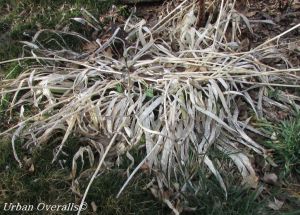Early spring. It is full of hope and promise. Birds are returning from their winter homes. Snowstorms are subsiding. Daytime temperatures are warming. Greenhouses are filling with plants. Wishful thinking and daydreams are occupying gardener’s minds.
But as gardeners, we know that one big task is just on the horizon. In fact, it is THE task that must be done before seeding and transplanting can take place in our garden beds. And at a glance, we can tell it still needs to be done. That task is spring cleanup.
spent iris debris
What is spring cleanup you ask? Why it a checklist of outdoor projects that should be completed prior to planting. Such tasks may include, but not limited to:
- Raking leaves out of ornamental beds and away from water features
- Pruning vines such as grapes
- Removing winter mulch from designated vegetable beds
- Cleaning up dead plants and leaves from last fall (such as leaves from irises and day lilies)
- Cutting back spent perennials
- Removing winter protection from trees and shrubs
- Pruning dead, damaged, or crossing branches
- Resetting any plants, edging, or pathway pavers that may have heaved
- Composting any yard waste that will break down easily such as leaves, straw and/or hay mulch
- Applying preventative weed treatment to lawns (organic options are available)
- Repairing any damage to fences, patio furniture, or irrigation
- Top dress vegetable beds with aged compost
- Pulling up any early weeds
- Preparing lawn area if sections need to be reseeded
Now while March is prone to wild mood swings in weather, go out as soon as the snow has melted and the temperatures are tolerable. Wear a jacket if needed. If you are waiting for a perfect, 80F day, it may never happen and the next thing you know, it is late May and gardening season has begun without you. Start now.
To keep spring cleanup manageable, focus on one task at a time and see that task through to completion. If you start with raking, continue until it is all done. Not only does this give you a sense of accomplishment, but it keeps you from feeling overwhelmed by the checklist of projects if you try to work on multiple tasks at the same time.
Keep an eye on the weather. It may dictate what tasks you can accomplish on a given day. If it is windy, skip the raking. Think of something you could do indoors. Maybe you could move onto a task such as sanding the wooden picnic bench and applying a fresh coat of stain within the confines of the garage?
Gather all tools and/or equipment you will need for a project prior to starting the task. If you are going to cut back perennials, determine what you will need and go get those items. For example, you may want to gather: gloves, hand pruners, wheel barrow, and perhaps a kneeling pad.
So gardeners, spring cleanup gives you a leg up on the season. Tasks are completed prior to the hectic time of planting and harvesting. Prepped yards and garden beds provide a clear view of what else needs to be done, such as replacing plants that did not survive the winter. And it gets you back into a gardening frame of mind.
About the author: Connie Meyer grew up on a farm in rural Iowa which taught her many lessons:raising chickens, growing produce, enjoying raw milk, how to cook from scratch using whole foods, canning, mending clothes, and the importance of being someone who gives back to the community. Now living in an urban setting, she brings her country ways to the city. Join Mr. and Mrs. Overalls as they share their adventures, recipes, and how-tos from their 1/3 acre slice of heaven near the center of town. See more great stuff on their blog: http://urbanoveralls.net/
Similar Stories:
- Pruning Trees and Shrubs
- Winter gardening things you should not overlook
- 15 Vegetable Crops To Start Planting for Fall
- Growing Figs In a Temperate Climate
- Federally Funded Grants for US Farmers





